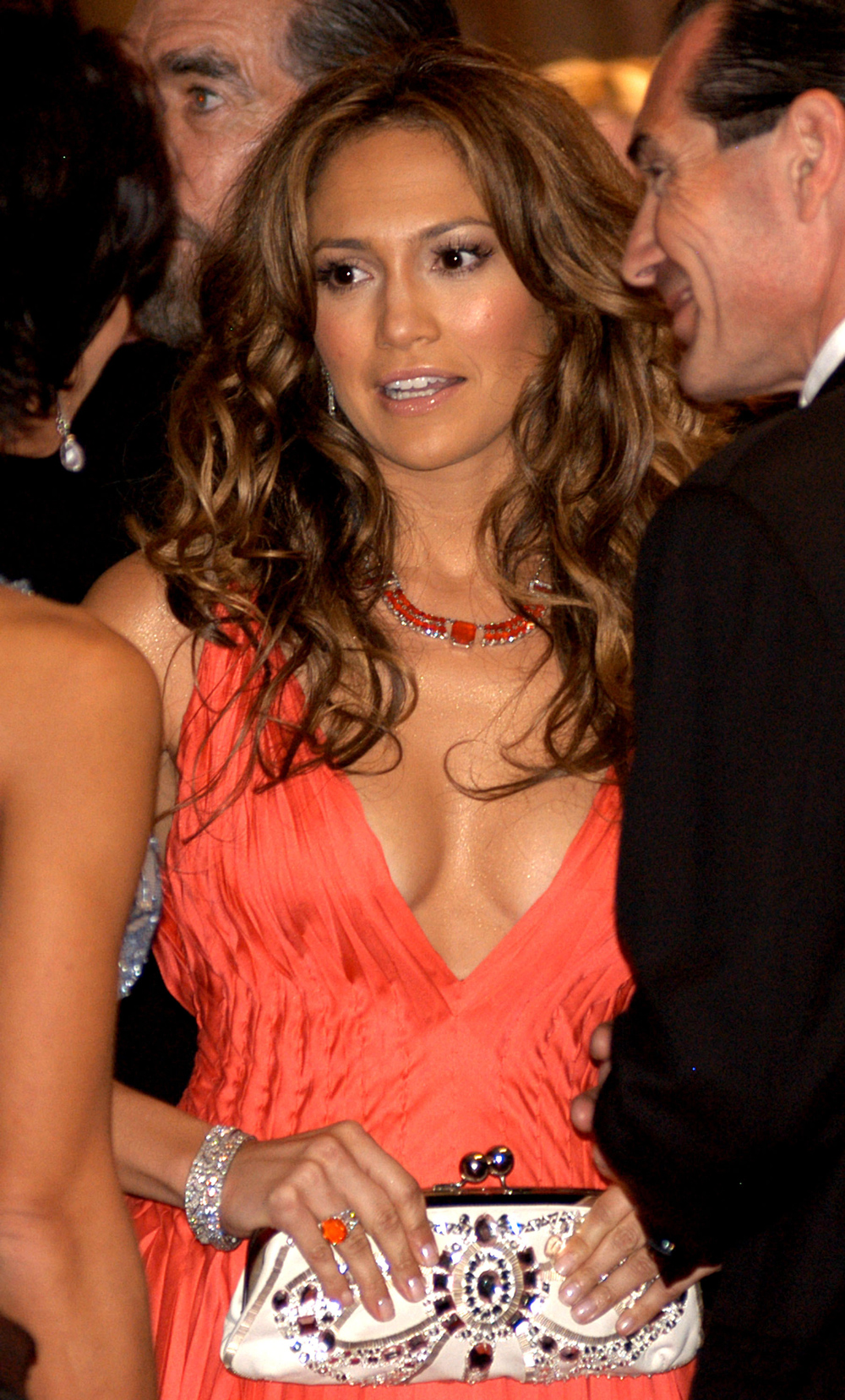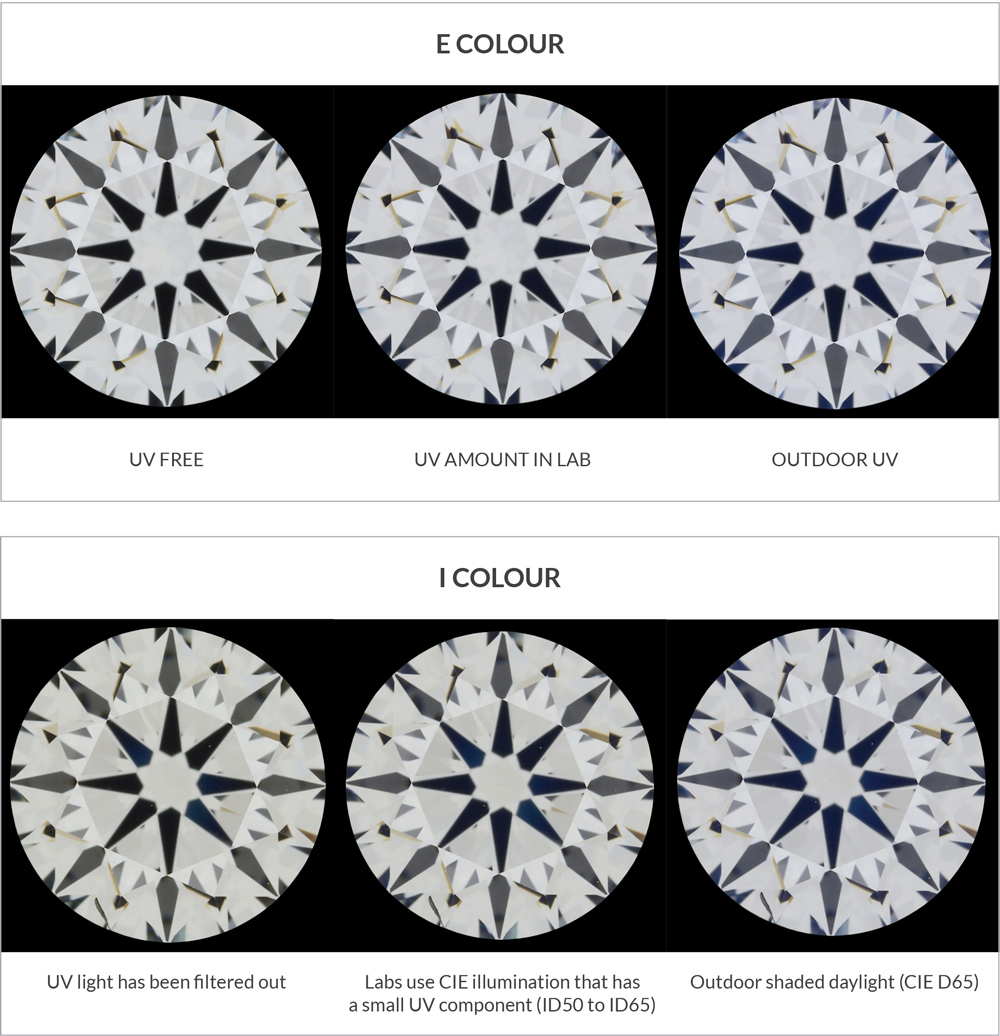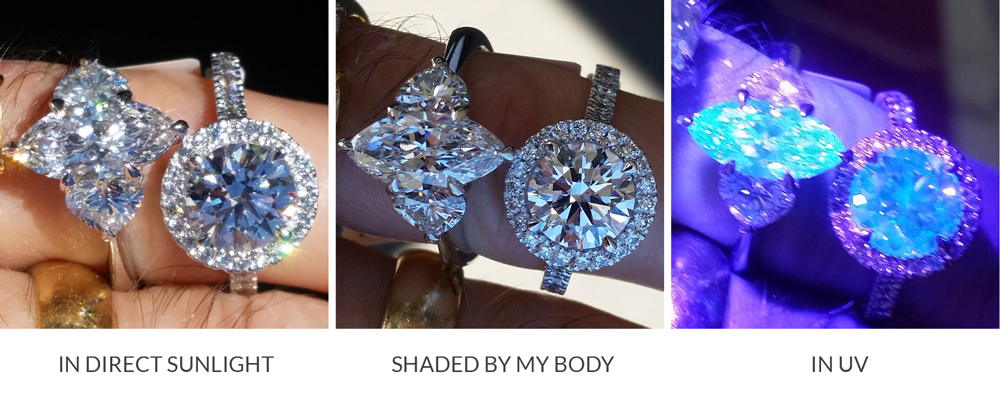No products in the cart.
Learn: Diamonds > Fluorescence
Introduction
Will Prices Keep Falling?
What is Fluorescence
How To Test For Hazy Fluorescent Diamonds?
The Internet & Fluoresence
Identify Milky, Hazy Fluorescent Diamonds
GIA Over Graded Colour
What Causes Fluorescents?
Big Brands
Yellow Fluoresence Diamonds
Milky Haze Fluoresence Diamonds
Blue Fluorescent Diamonds in Sunlight
Fluorescence
Myths & Facts
1. Fluorescent diamonds are hazy and dull:
Wrong. Very few are. Most are brighter and whiter
2. D Flawless fluorescent diamonds are the haziest:
Wrong. Haziness is as likely to occur in a low colour and far less likely in a flawless than an SI diamond

Read on for all the answers
What is fluorescence?
About a third of all diamonds fluoresce in ultraviolet (UV) light. About 90% fluoresce blue. GIA and most other labs grade the fluorescence of diamonds as None, Faint, Medium, Strong, and Very Strong.
The internet and fluorescence
It is natural for people shopping for expensive jewellery to research online. Overwhelmingly they read that strong fluorescent high colour and clarity diamonds are sold at a discount. In anyone’s mind that translates to ‘not as good’ or ‘to be avoided’.
How then could it have been that until around 40 years ago, top quality blue fluorescent diamonds traded at a premium? As a natural phenomenon that improves the colour of most fluorescent diamonds, it was considered a plus, except in rare cases where it made the diamond look dull. So what changed?
- GIA over graded the colour of stronger blue fluorescent diamonds (until the year 2000)
- In 1993 Korean labs and jewellers were caught over grading color
- Big brands bad mouth fluorescence
- Some fluorescent diamonds are milky and hazy (and that is bad)
- In the past decade ‘fake information’ online has lowered prices even further
We will work through each of the first three issues and how the fourth can be avoided. Then we will look at the benefits of blue fluorescence in diamonds, especially the combined lower prices and increased beauty and new research from GIA that supports the Holloway belief in that carefully screened fluorescent diamonds are better than non fluorescent diamonds.

GIA strong blue fluorescent diamonds appear whiter in bright lighting.
The blue from fluorescence cancels out yellowish or brownish tints that are common in most diamonds. The result is that in better lighting, that is required to notice subtle shades of colour, fluorescent diamond generally appear to be a whiter than their GIA colour grade. Top coloured D to F diamonds can appear highly desirable blue white.
Fluorescent diamonds generally appear whiter
GIA over graded colour
Prior to the 1990’s grading reports or certs were only common for plus one carat, D-E colour flawless to VVS clarity very rare diamonds.
This began to change in the mid 1990’s when Martin Rapaport launched RapNet®, a dial up internet diamond trading platform. Grading reports became essential for transactions at distance, especially international business to business trading given that India had begun to take over the lion’s share of diamond cutting. Soon even lower grade smaller diamonds were being sent to labs for grading. Back then GIA’s colour grading set up had way too much UV light, and as a result stronger blue fluorescent diamonds were being over graded by one to three colour grades. The result: dealers began discounting fluorescent diamonds.
However, around the year 2000 GIA reduced the UV output of its colour grading lamps and increased the distance from the lamps to the diamond thereby reducing the strength of the radiation. In a GIA research paper published in 2008 there is a description of the process which included using the international commission on lighting (CIE) references for daylight and indoor lighting. GIA now grades in a fair and balanced lighting environment. Sadly diamond dealers and traders rarely bother to read scientific journals. And not that many have undertaken gemological training. Few are aware that GIA changed their grading environment and perhaps GIA does not want to promote the idea that some diamonds they graded before the changes may in fact receive a lower grade today. The myth of over grading of blue fluorescent diamond colour persists.
In very strong LED lighting, that is usually devoid of UV, it is possible that a strong blue fluorescent diamond may appear a half to a full grade lower in colour. But, on a bright cloudy day, that same stone may improve by a colour grade or two. Overall, that is a win for fluorescence. Because of the lighting that you would require to.

GIA over-graded blue fluorescent diamonds prior to 2000.
Left: Before 2000 GIA colour grading lamps emitted a lot of UV. Grading was done too close to the light.
Right: Since 2000 GIA uses low UV emission lamps and diamonds are graded from further away at a pre-set distance.
Left: Before 2000 GIA colour grading lamps emitted a lot of UV. Grading was done too close to the light.
Right: Since 2000 GIA uses low UV emission lamps and diamonds are graded from further away at a pre-set distance.

Left: This image is rather famous. It is a necklace made by Harry Winston, ‘the king of Diamonds’ who passed away in 1978. The necklace attributed to him was published in a Gems & Gemology 1997 article on fluorescent diamonds. Clearly Harry Winston preferred fluorescent diamonds. Unfortunately, that is not the case today at ‘HW’ as the text inset attests. GIA and Harold & Erica Van Pelt. Courtesy: Harry Winston, Inc.
Right: part of the ‘Court of Jewels’ that Harry exhibited on a world tour included two of the worlds most famous diamonds. The Hope (the smaller blue diamond) and the Portuguese (the emerald cut). Both are on exhibition at the Smithsonian in Washington DC. Both have unusual fluorescence. Courtesy: Harrywinston.com
Right: part of the ‘Court of Jewels’ that Harry exhibited on a world tour included two of the worlds most famous diamonds. The Hope (the smaller blue diamond) and the Portuguese (the emerald cut). Both are on exhibition at the Smithsonian in Washington DC. Both have unusual fluorescence. Courtesy: Harrywinston.com
Big Brands
Big prestigious international jewelry brands train sales associates to tell consumers to avoid strong fluorescent diamonds. This may be partly because GIA does not teach identification of reduced transparency in fluorescent diamonds. Perhaps big brands also do not wish to spend the effort to train sales associates to sell fluorescent diamonds?
Harry Winston, who died more than 40 years ago, was called the King of Diamonds and acknowledged as a diamond expert. Garry Holloway had a friend who trained and worked there for many years. He asked him:
“Did Harry have processes to screen out milky hazy stones?
“Winston had a category called “Premier” which were Medium- Strong blue D-E colours that looked “super white”…they sold at a premium. Screening – all grading was done by old timers – Winston trained graders. It’s quite easy to screen hazy stones. They used diamond grading lamps and large north facing windows.”
Milky hazy fluorescent diamonds
These are a real problem. As labs do not grade transparency or describe a diamond as hazy or milky with reduced sparkle is both a very real problem and a genuine fear.
On top of that, GIA does not identify milky or haziness; that is lumped in with clarity grading. There should be a transparency grade. In addition, for fluorescent diamonds, grading of transparency should also be done in lighting that is in a UV rich environment.

Two halves of two strong blue fluorescent diamonds: The left half is milky or hazy and the right half is crystal clear. We screen out bad diamonds giving our clients the benefit of whiter and brighter diamonds.

Will prices keep falling?
Who knows, but there is a rumbling from some powerful players; the biggest diamond miners and new GIA research supporting the benefits of blue diamond fluorescence. They do not like if rough diamond values fall, that is not part of their game plan. Already Russia’s ALROSA, the largest diamond miner, has begun a promotion called Luminous Diamonds®. They have hired celebrities including JayLo (Jennifer Lopez). The Natural Diamond Council is also promoting Luminous Diamonds®.
Based on this small survey shown here that was conducted on Rapaports’ RapNet®, the recent rise in discounts that RapNet report has not exaggerated the situation.
Imagine if the diamond world went back to realizing the benefits of strong blue fluorescent diamonds! Imagine they became more prized for their rarity and natural beauty? For their party trick inner glow? Instead of being discounted, they sold for a premium.
There would be two important issues to solve:
- Introduce a measurement or assessment method to rate a diamond’s transparency or translucency.
- Devise a method to demonstrate colour improvement.
Strong fluorescent diamonds can improve by in colour in daylight or near a window. Overall, that is a win for fluorescence.
How do you test for hazy fluorescent diamonds?
To reject or avoid hazy milky diamonds like the left half image of two Strong fluorescent stones shown, first you must look at the diamond in light that has a lot of UV. This should not be direct sunlight or UV light alone. The diamond on the left half is hazy and milky when seen in shaded daylight or when held very close to a bright daylight or cool white fluorescent tube (most emit a fair amount of UV light).

The diamond on the left is hazy because it has scattered inclusions that when combined with fluorescence cause the diamond to appear milky and hazy in any light that has uv like shaded daylight. Both diamonds are strongly fluorescent. Holloway diamonds™ are all screened for maximum transparency.

Identifying milky, hazy fluorescent diamonds?
Firstly avoid certain types of inclusions that are marked or commented in GIA grading reports. The two of the worst inclusions are Internal Graining and Clouds. Very rarely, twinning can cause some milkiness too if it is the main grading feature of a lower clarity Strong or Very Strong fluorescent diamond. Nevertheless, I’ve come across Flawless diamonds that are milky and cloudy simply because they had internal graining inclusions that GIA did not identify or mention on the grading report (it is common for this to be missed by labs). One is shown here. Sometimes the graining is clearly visible in better quality videos and photos of diamonds.
Many expert people in the diamond industry maintain that medium blue fluorescent diamonds are safe to buy. Unfortunately, that is not true because these can also be milky or hazy, and this diamond is an example. (The full report is not shown as it would not be fair if a reader owned this diamond.
Here’s a Clarity rule of thumb: the lower the grade, the more impact cloud or internal graining will impact the transparency of the diamond. This is doubly true for fluorescent diamonds. While diamonds with external graining may be OK, practice some caution because an external grain is likely to intrude further into the diamond.
If you’re examining a diamond inside a store that only has LED lights and no daylight coming through windows, it’s quite possible that the stone’s haziness will go undetected. White LEDs do not produce the type of UV light that cause graining and clouds to light up and make the stone look milky dull white. Ask to view the diamond in shaded daylight or at least near a window so that there is some UV light. You can also buy a cheap $5 UV penlight and see if a fluorescent diamond lights up bright pale blue (bad) or darker blue (good ).
What causes Fluorescence?
Tiny traces of nitrogen are present in all diamonds. When there are large enough amounts arranged in the atomic lattice, UV or just-visible violet light causes electrons in the inner shells of Nitrogen atoms to momentarily jump to the outer shells. As they drop back they emit energy in the form of the powder-blue colored light. If a UV light is shone on fluorescent diamonds in the dark and the UV light is turned off, some diamonds will continue to glow or phosphoresce for a few seconds. Interestingly most synthetic or lab grown diamonds have a more pronounced and persistent phosphorescence. This is one of the simple identification tests, especially for smaller sizes of diamonds because hundreds of diamonds may be checked simultaneously at a glance.


Very Strong yellow fluorescence makes this neon green-yellow diamond attractive
Yellow Fluorescent Diamonds
More than 90% of fluorescent colourless diamonds exhibit blue luminescence. However, yellow, green, orange and red can also occur. When a colourless or near colourless diamond fluoresces yellow it lowers the apparent color grade in UV rich lighting. In this case a discount is appropriate. Yellow fluorescence should definitely be avoided in colourless diamonds. Yellow fluorescence benefits Fancy Yellow diamonds (where yellow and green fluorescence then becomes a benefit). Note also that in the fluorescence discount survey above of 1,822 diamonds none displayed strong or “very-strong” yellow fluorescence.
Blue Fluorescence and diamonds in the sunlight
It is true that a blue fluorescent diamond can look strange or beautiful in direct sunlight. Strange because some will glow as if it were radioactive, or beautiful because you are attracted to that inner glow. However, the blue that most people see when they view any diamond in direct sunlight is most often the blue from the sky, not the blue fluorescence at all.
There is no good reason to look at a diamond in direct sunlight. If you want to have fun with the fluorescence get a cheap $5 UV torch because they produce the perfect radiation to get the strongest blue fluorescence. It is best to turn the lights out or look at the diamond under a desk.
My diamond goes dark in sunlight. This is a frequently raised question by consumers when they get their new diamond ring. They rush outside on a sunny day expecting the diamond to go berserk.
The better the cut quality and light return, the darker a diamond will appear in direct sunlight!
This effect is independent of whether the diamond is fluorescent or not. What’s more, the few very bright flashes can damage your eyes because you are effectively looking directly at the sun! So please, just don’t do it! Choose a cloudy day under a broad leaf tree and then you will be blown away because there will be hundreds of tiny pinpoints of light.

Left: The round cut is dark blue. The marquise is the brightest.
Middle: The round brilliant cut really is brighter than the marquise.
Right: The marquise is strong blue fluorescent and the round is only faintly fluorescent.
